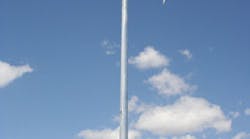Located in a rare wooded area of Texas, about 25 miles north of Dallas, Paul Westbrook didn’t expect his home to be a suitable candidate for wind power. But with an average wind speed of just under 11 mph, he’s now able to use Southwest Windpower’s new Skystream 3.7 residential small wind generator to meet about one-third of his home’s power needs.
“My house is about 2,700 square feet, and due to our efficient installations, solar water heating, and geothermal heat pump, our average consumption is a little over 800kW hours per month,” Westbrook says. “If I’m really getting the full Dallas/Fort Worth average [wind speed], then I would get about 300kW hours per month [from Skystream 3.7].”
In fact, Westbrook adds that another Skystream 3.7 user in Amarillo, Texas, which is much windier, gets seven to eight times more power than he does from the same unit.
Since the company’s inception 20 years ago, Southwest Windpower, Flagstaff, Ariz., has manufactured more than 100,000 wind generators, but Skystream 3.7, which became commercially available this month, is its first fully integrated wind generator designed for the grid-connected residential market. Andrew Kruse, the company’s vice president of business development, says the firm began designing this wind generator five years ago in response to a growing interest from consumers wanting to produce their own power. In fact, as evidence of this demand, he says the solar industry has been growing at a rate of about 60% a year over the past five years.
This is good news for Skystream 3.7, especially considering wind power’s apparent price advantage over solar. “Traditionally wind energy is about a half to a quarter of the cost to produce electricity than what solar is,” he says. “So this particular machine produces energy for about half to a third the costs of solar, provided you have the wind, of course.”
Approximately 9 mph is the minimum recommended average wind speed for those interested in Skystream 3.7. Electrical contractors interested in advising clients on whether or not this is a good energy option for their homes can figure out the average wind speed for a given site through links to wind maps on Southwest Windpower’s Web site. The wind turbine also must stand at least 20 feet above any surrounding objects within a 250-foot radius.
Skystream 3.7’s turbine blades are designed to improve efficiency and cut back on tip-speed noise with a unique curved shape. The nacelle behind the blades of the turbine houses all of the wind generator’s operational elements, such as its alternator, inverter, and synchronizer. “There are four connection screws on the bottom that you attach four wires to — ground, neutral, and your two hot wires — and then you bring them right back in to your electrical panel and terminate them on a double-poled breaker,” Westbrook says.
Kruse explains that while wind generators have been around for about a century, they have traditionally required a lot of maintenance and had a lot of external boxes and controllers to complicate the installation process. “This is the first type of design where everything is built into the machine so that all you do is put it up on the tower, run wires to your house, and it’s ready to go,” he says.
The alternator used in this unit is a permanent magnet brushless type that takes the power directly off the alternator and sends it to the inverter, which according to Kruse, gives more energy production than a fixed rpm synchronous machine. The slotless alternator design uses a flat wire that helps eliminate low-end cogging, which is a derivative of noise.
The generator is designed to automatically shut down if the grid goes down, so that the power generated by the unit doesn’t feed back onto the grid. This helps keep linemen that may be working on the line to restore service safe. However, in normal operating mode, if the generator creates more power than the home requires, the excess power that flows back into the grid is credited to the homeowner. The company says that Skystream 3.7 can provide 30% to 80% of an average home’s energy needs.
The average total installed cost of the wind generator is expected to be between $10,000 and $12,000. Depending on wind speed, Skystream can pay for itself in five to 12 years, according to the company. For more information, visit www. skystreamenergy.com.
Product Specs
Rated capacity: 1.8kW, 2.4kW peak
Weight: 170 lbs / 77 kg
Rotor diameter: 12 ft / 3.72 m
Blade material: Fiberglass reinforced composite
Rated speed: 50 rpm to 325 rpm
Braking system: Electronic stall regulation with redundant relay switch control
User control: Wireless two-way interface remote system
Survival wind speed: 140 mph / 63 m/sec
Warranty: Five-year limited warranty



